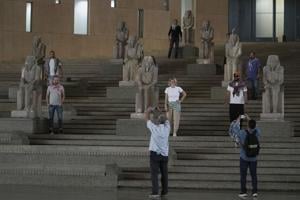World
Egypt Celebrates Grand Opening of the New Egyptian Museum

Egypt has officially inaugurated the Grand Egyptian Museum (GEM), a significant addition to its cultural landscape, with a grand ceremony that showcased the nation’s storied history. Located near the Giza Pyramids and the Sphinx, this long-anticipated facility aims to modernize the display of Egypt’s ancient treasures and bolster the nation’s tourism sector.
The ceremony took place on March 15, 2024, and featured a spectacular drone light show that depicted ancient gods and iconic pyramids. Egyptian President Abdel Fattah el-Sissi emphasized the museum’s role in fostering international dialogue and tourism, stating, “Make this museum a platform for dialogue, a destination for knowledge, a forum for humanity, and a beacon for all who love life and believe in the value of humankind.”
A Monument to Ancient Heritage and Modern Ambitions
The Grand Egyptian Museum, touted as the world’s largest museum dedicated to a single ancient civilization, has been nearly two decades in the making. Construction began in 2005 during the presidency of Hosni Mubarak, but the project faced multiple delays, particularly due to the political upheaval surrounding the 2011 Arab Spring. Following years of uncertainty, the GEM is positioned as a key element in Egypt’s strategy to revitalize its tourism industry, which has faced numerous challenges, including the impacts of the COVID-19 pandemic and regional conflicts.
The GEM is expected to attract approximately 5 million visitors annually, placing it among the world’s leading museums. For comparison, Paris’s Louvre welcomed 8.7 million visitors in 2024, while the British Museum and the Metropolitan Museum of Art in New York received 6.5 million and 5.7 million visitors, respectively.
Showcasing King Tutankhamun’s Treasures
A highlight of the museum is its extensive collection of artifacts from the tomb of King Tutankhamun, which has not been displayed in its entirety since its discovery in 1922. This collection includes significant items such as the young pharaoh’s gold-covered sarcophagus, elaborate funeral beds, and his iconic burial mask, crafted from gold, quartzite, lapis lazuli, and colored glass.
Egypt’s Minister of Tourism and Antiquities, Sherif Fathy, expressed optimism about the museum’s potential economic impact. He noted that the GEM, alongside enhancements to the surrounding area, including new highways and the recently opened Sphinx International Airport, will help attract more tourists. Following years of decline, the tourism sector is gradually recovering, with a record of 15.7 million tourists visiting Egypt in 2024. Officials project that this figure could rise to 18 million in 2025, with aspirations of reaching 30 million by 2032.
Zahi Hawass, a prominent Egyptian archaeologist and former Minister of Antiquities, highlighted the significance of the museum, stating, “Why this museum is so important, and everyone is waiting for the opening? Because of Tutankhamun.”
The Grand Egyptian Museum not only represents a lasting tribute to Egypt’s ancient civilization but also serves as a critical component in the nation’s efforts to stimulate economic growth through cultural tourism. With its modern facilities and vast collections, the museum is set to become a beacon of heritage and a source of pride for Egyptians and visitors alike.
-

 Top Stories1 week ago
Top Stories1 week agoMarc Buoniconti’s Legacy: 40 Years Later, Lives Transformed
-

 Sports3 weeks ago
Sports3 weeks agoSteve Kerr Supports Jonathan Kuminga After Ejection in Preseason Game
-

 Science3 weeks ago
Science3 weeks agoChicago’s Viral ‘Rat Hole’ Likely Created by Squirrel, Study Reveals
-

 Politics3 weeks ago
Politics3 weeks agoDallin H. Oaks Assumes Leadership of Latter-day Saints Church
-

 Business3 weeks ago
Business3 weeks agoTyler Technologies Set to Reveal Q3 2025 Earnings on October 22
-

 Lifestyle3 weeks ago
Lifestyle3 weeks agoDua Lipa Celebrates Passing GCSE Spanish During World Tour
-

 Lifestyle3 weeks ago
Lifestyle3 weeks agoKelsea Ballerini Launches ‘Burn the Baggage’ Candle with Ranger Station
-

 Entertainment3 weeks ago
Entertainment3 weeks agoZoe Saldana Advocates for James Cameron’s Avatar Documentary
-

 Health3 weeks ago
Health3 weeks agoRichard Feldman Urges Ban on Menthol in Cigarettes and Vapes
-

 Sports3 weeks ago
Sports3 weeks agoPatriots Dominate Picks as Raiders Fall in Season Opener
-

 Health3 weeks ago
Health3 weeks agoCommunity Unites for Seventh Annual Mental Health Awareness Walk
-

 Business3 weeks ago
Business3 weeks agoMega Millions Jackpot Reaches $600 Million Ahead of Drawings









